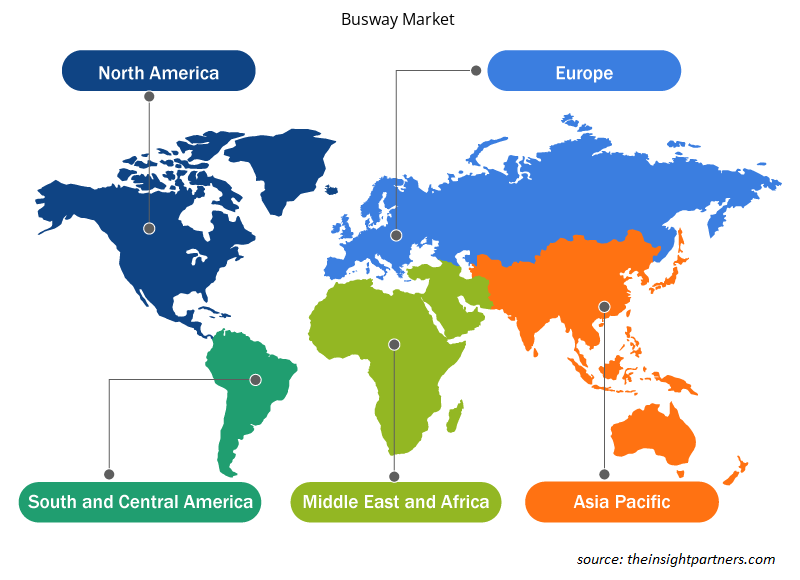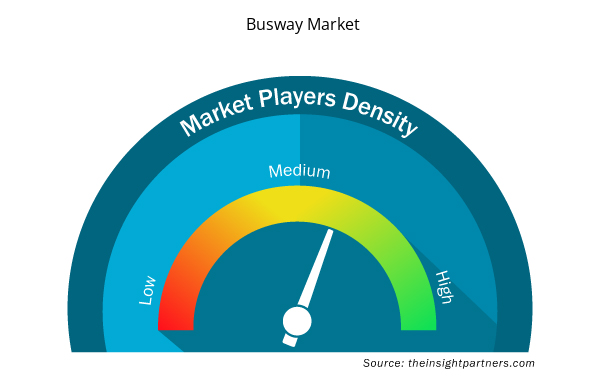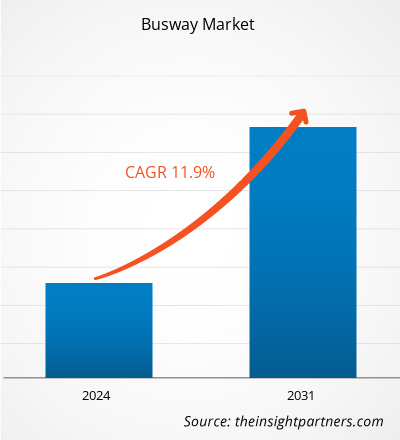Der Markt für Schienenverteiler soll von 8,45 Milliarden US-Dollar im Jahr 2023 auf 20,76 Milliarden US-Dollar im Jahr 2031 anwachsen. Der Markt wird voraussichtlich zwischen 2023 und 2031 eine durchschnittliche jährliche Wachstumsrate von 11,9 % verzeichnen. Die steigende Nachfrage nach Elektrizität und die zunehmende Industrialisierung werden voraussichtlich weiterhin die wichtigsten Trends auf dem Schienenverteilermarkt bleiben.
Busway-Marktanalyse
In den verschiedenen Regionen dieser Branche sind unterschiedliche Wachstumstrends zu beobachten. Die entwickelten Märkte Nordamerikas (NA) und Europas (ELI) machen einen erheblichen Teil des weltweiten Marktanteils aus; Entwicklungsländer in Regionen wie Asien-Pazifik (APAC), dem Nahen Osten und Afrika (ME), Afrika und Südamerika (SAM) verzeichnen jedoch aufgrund verschiedener Faktoren wie der Notwendigkeit der Elektrifizierung und des Wachstums neuer Industrien und Infrastrukturen ein rasantes Wachstum. Aufgrund des Ausbaus der Stromnetze und der Entwicklung erneuerbarer Energieanlagen weltweit wird die Nutzung von Stromschienen in den kommenden Jahren voraussichtlich rasant zunehmen.
Übersicht zum Busway-Markt
Die National Electrical Manufacturers Association (NEMA) definiert einen Schienenverteiler als vorgefertigtes elektrisches Verteilungssystem, das aus geraden Leitungen, Armaturen, Geräten und Zubehör besteht, die alle in einem Schutzgehäuse untergebracht sind. Schienenverteiler transportieren Strom und verbinden ihn mit elektrischen Geräten wie Transformatoren, Schalttafeln und Schaltanlagen . In gewerblichen und industriellen Anwendungen ist ein Schienenverteiler ein hervorragender Ersatz für Kabel und Leitungen, da er einfacher zu ersetzen, weniger teuer zu installieren und weniger Konfigurationsaufwand erfordert – insbesondere in Szenarien, in denen die Lastpositionen wahrscheinlich variieren.
Passen Sie diesen Bericht Ihren Anforderungen an
Sie erhalten kostenlose Anpassungen an jedem Bericht, einschließlich Teilen dieses Berichts oder einer Analyse auf Länderebene, eines Excel-Datenpakets sowie tolle Angebote und Rabatte für Start-ups und Universitäten.
- Holen Sie sich die wichtigsten Markttrends aus diesem Bericht.Dieses KOSTENLOSE Beispiel umfasst eine Datenanalyse von Markttrends bis hin zu Schätzungen und Prognosen.
Treiber und Chancen auf dem Busway-Markt
Steigende Nachfrage nach Elektrizität begünstigt den Markt.
Der Stromverbrauch hat in den letzten Jahrzehnten zugenommen und ist heute für moderne Volkswirtschaften unverzichtbar. Aufgrund des steigenden verfügbaren Einkommens wird erwartet, dass dieser Bedarf in den kommenden Jahren weiter steigen wird. Der gestiegene Stromverbrauch hat zu einem Anstieg des Stromverbrauchs in Endverbraucherindustrien und Automobilen geführt. Es gibt zwei unterschiedliche geografische Muster für den Stromverbrauch. Gewinne bei der Energieeffizienz gleichen das zukünftige Wachstum aus, das mit der zunehmenden Elektrifizierung und Digitalisierung in fortgeschrittenen Volkswirtschaften einhergeht.
Zunehmende Industrialisierung
Die zunehmende Industrialisierung führt zur Entwicklung neuer Fabriken und Fertigungsanlagen, die eine robuste elektrische Infrastruktur für Antriebsmaschinen und -geräte benötigen, wodurch eine Nachfrage nach Stromschienensystemen zur effizienten Stromverteilung entsteht.busway systems to efficiently distribute electricity.
Segmentierungsanalyse des Busway-Marktberichts Market Report Segmentation Analysis
Wichtige Segmente, die zur Ableitung der Busway-Marktanalyse beigetragen haben, sind Typen und Anwendungen.busway market analysis are types and applications.
- Basierend auf den Typen ist der Schienenverteilermarkt in luftgekoppelte Schienenverteiler (BMC), Schienenverteiler mit intensiver Isolierung (CMC), hochfeste geschlossene Schienenverteiler (CFW) und andere unterteilt.busway market is divided into air splicing busways (BMC), intensive insulation plugs busways (CMC), high-strength enclosed busways (CFW), and others).
- Nach Anwendung ist der Markt in Gewerbegebäude, Wohngebäude, industrielle Infrastruktur und Sonstiges segmentiert.
Busway-Marktanteilsanalyse nach Geografie Market Share Analysis by Geography
Der geografische Umfang des Berichts zum Busway-Markt ist hauptsächlich in fünf Regionen unterteilt: Nordamerika, Asien-Pazifik, Europa, Naher Osten und Afrika sowie Südamerika/Süd- und Mittelamerika. Nordamerika hat den Busway-Markt dominiert. Trends zur Einführung hochtechnologischer Technologien in verschiedenen Branchen in der nordamerikanischen Region haben das Wachstum des Busway-Marktes vorangetrieben. Darüber hinaus zwingt eine starke Betonung von Forschung und Entwicklung in den entwickelten Volkswirtschaften der USA und Kanadas die nordamerikanischen Akteure dazu, technologisch fortschrittliche Lösungen auf den Markt zu bringen. Darüber hinaus gibt es in den USA viele Busway-Marktakteure, die sich zunehmend auf die Entwicklung innovativer Lösungen konzentrieren. All diese Faktoren tragen zum Wachstum des Busway-Marktes in der Region bei.busway market report is mainly divided into five regions: North America, Asia Pacific, Europe, Middle East & Africa, and South America/South & Central America. North America has dominated the busway market. High technology adoption trends in various industries in the North American region have fuelled the growth of the busway market. Moreover, a strong emphasis on research and development in the developed economies of the US and Canada is forcing the North American players to bring technologically advanced solutions into the market. In addition, the US has many busway market players who have been increasingly focusing on developing innovative solutions. All these factors contribute to the region's growth of the busway market.
Regionale Einblicke in den Busway-Markt Market Regional Insights
Die regionalen Trends und Faktoren, die den Busway-Markt im Prognosezeitraum beeinflussen, wurden von den Analysten von Insight Partners ausführlich erläutert. In diesem Abschnitt werden auch Busway-Marktsegmente und -Geografie in Nordamerika, Europa, im asiatisch-pazifischen Raum, im Nahen Osten und Afrika sowie in Süd- und Mittelamerika erörtert.Busway Market throughout the forecast period have been thoroughly explained by the analysts at Insight Partners. This section also discusses Busway Market segments and geography across North America, Europe, Asia Pacific, Middle East and Africa, and South and Central America.

- Holen Sie sich regionale Daten zum SchienenverteilermarktBusway Market
Umfang des Busway-Marktberichts
| Berichtsattribut | Details |
|---|---|
| Marktgröße im Jahr 2023 | 8,45 Milliarden US-Dollar |
| Marktgröße bis 2031 | 20,76 Milliarden US-Dollar |
| Globale CAGR (2023 - 2031) | 11,9 % |
| Historische Daten | 2021-2022 |
| Prognosezeitraum | 2024–2031 |
| Abgedeckte Segmente | Nach Typ
|
| Abgedeckte Regionen und Länder | Nordamerika
|
| Marktführer und wichtige Unternehmensprofile |
|
Dichte der Marktteilnehmer für Busbahnen: Die Auswirkungen auf die Geschäftsdynamik verstehen
Der Markt für Schienenverteiler wächst rasant, angetrieben durch die steigende Nachfrage der Endnutzer aufgrund von Faktoren wie sich entwickelnden Verbraucherpräferenzen, technologischen Fortschritten und einem größeren Bewusstsein für die Vorteile des Produkts. Mit steigender Nachfrage erweitern Unternehmen ihr Angebot, entwickeln Innovationen, um die Bedürfnisse der Verbraucher zu erfüllen, und nutzen neue Trends, was das Marktwachstum weiter ankurbelt.
Die Marktteilnehmerdichte bezieht sich auf die Verteilung der Firmen oder Unternehmen, die in einem bestimmten Markt oder einer bestimmten Branche tätig sind. Sie gibt an, wie viele Wettbewerber (Marktteilnehmer) in einem bestimmten Marktraum im Verhältnis zu seiner Größe oder seinem gesamten Marktwert präsent sind.
Die wichtigsten auf dem Schienenverteilermarkt tätigen Unternehmen sind:
- Schneider Electric
- Siemens
- Eaton
- LS Kabel und Systeme
- Netzstecker Busduct Sdn. Bhd.
- ABB
Haftungsausschluss : Die oben aufgeführten Unternehmen sind nicht in einer bestimmten Reihenfolge aufgeführt.

- Überblick über die wichtigsten Akteure auf dem Busway-Markt
Neuigkeiten und aktuelle Entwicklungen zum Schienenverteilermarkt
Der Busway-Markt wird durch die Erhebung qualitativer und quantitativer Daten nach Primär- und Sekundärforschung bewertet, die wichtige Unternehmensveröffentlichungen, Verbandsdaten und Datenbanken umfasst. Im Folgenden finden Sie eine Liste der Entwicklungen auf dem Markt:
- Im Juni 2021 gab das Energiemanagementunternehmen Eaton bekannt, dass es die Übernahme eines 50-prozentigen Anteils am Schienenverteilergeschäft von Jiangsu YiNeng Electric abgeschlossen habe. Das Unternehmen stellt Schienenverteilerprodukte in China her und vermarktet sie und erzielte im Jahr 2020 einen Umsatz von 60 Millionen US-Dollar.
(Quelle: Eaton, Pressemitteilung, 2021)
Abdeckung und Ergebnisse des Marktberichts zu Schienenverteilern
Der Bericht „Marktgröße und Prognose für Busway-Systeme (2021–2031)“ bietet eine detaillierte Analyse des Marktes, die die folgenden Bereiche abdeckt:
- Marktgröße und Prognose auf globaler, regionaler und Länderebene für alle wichtigen Marktsegmente, die im Rahmen des Projekts abgedeckt sind
- Marktdynamik wie Treiber, Beschränkungen und wichtige Chancen
- Wichtige Zukunftstrends
- Detaillierte PEST/Porters Five Forces- und SWOT-Analyse
- Globale und regionale Marktanalyse mit wichtigen Markttrends, wichtigen Akteuren, Vorschriften und aktuellen Marktentwicklungen
- Branchenlandschaft und Wettbewerbsanalyse, einschließlich Marktkonzentration, Heatmap-Analyse, prominenten Akteuren und aktuellen Entwicklungen
- Detaillierte Firmenprofile
- Historische Analyse (2 Jahre), Basisjahr, Prognose (7 Jahre) mit CAGR
- PEST- und SWOT-Analyse
- Marktgröße Wert/Volumen – Global, Regional, Land
- Branche und Wettbewerbsumfeld
- Excel-Datensatz


- Green Hydrogen Market
- Military Rubber Tracks Market
- Adaptive Traffic Control System Market
- Compounding Pharmacies Market
- Airport Runway FOD Detection Systems Market
- Transdermal Drug Delivery System Market
- Ceramic Injection Molding Market
- Single Pair Ethernet Market
- Explosion-Proof Equipment Market
- Real-Time Location Systems Market

Report Coverage
Revenue forecast, Company Analysis, Industry landscape, Growth factors, and Trends

Segment Covered
This text is related
to segments covered.

Regional Scope
North America, Europe, Asia Pacific, Middle East & Africa, South & Central America

Country Scope
This text is related
to country scope.
Häufig gestellte Fragen
The global busway market is expected to reach US$ 20.76 billion by 2031.
The key players holding majority shares in the global busway market are Schneider Electric; Siemens, Eaton, LS Cables, and Systems; and Power Plug Busduct Sdn. Bhd.; ABB; Powerwell; Honeywell International Inc.; Furukawa Electric Co., Ltd.; WOER.
Increasing demand for electricity is the major factors that propel the global busway market.
Growing industrialization, which is anticipated to play a significant role in the global busway market in the coming years.
The global busway market was estimated to be US$ 8.45 billion in 2023 and is expected to grow at a CAGR of 11.9% during the forecast period 2024 - 2031.
Trends and growth analysis reports related to Electronics and Semiconductor : READ MORE..
The Insight Partners performs research in 4 major stages: Data Collection & Secondary Research, Primary Research, Data Analysis and Data Triangulation & Final Review.
- Data Collection and Secondary Research:
As a market research and consulting firm operating from a decade, we have published and advised several client across the globe. First step for any study will start with an assessment of currently available data and insights from existing reports. Further, historical and current market information is collected from Investor Presentations, Annual Reports, SEC Filings, etc., and other information related to company’s performance and market positioning are gathered from Paid Databases (Factiva, Hoovers, and Reuters) and various other publications available in public domain.
Several associations trade associates, technical forums, institutes, societies and organization are accessed to gain technical as well as market related insights through their publications such as research papers, blogs and press releases related to the studies are referred to get cues about the market. Further, white papers, journals, magazines, and other news articles published in last 3 years are scrutinized and analyzed to understand the current market trends.
- Primary Research:
The primarily interview analysis comprise of data obtained from industry participants interview and answers to survey questions gathered by in-house primary team.
For primary research, interviews are conducted with industry experts/CEOs/Marketing Managers/VPs/Subject Matter Experts from both demand and supply side to get a 360-degree view of the market. The primary team conducts several interviews based on the complexity of the markets to understand the various market trends and dynamics which makes research more credible and precise.
A typical research interview fulfils the following functions:
- Provides first-hand information on the market size, market trends, growth trends, competitive landscape, and outlook
- Validates and strengthens in-house secondary research findings
- Develops the analysis team’s expertise and market understanding
Primary research involves email interactions and telephone interviews for each market, category, segment, and sub-segment across geographies. The participants who typically take part in such a process include, but are not limited to:
- Industry participants: VPs, business development managers, market intelligence managers and national sales managers
- Outside experts: Valuation experts, research analysts and key opinion leaders specializing in the electronics and semiconductor industry.
Below is the breakup of our primary respondents by company, designation, and region:

Once we receive the confirmation from primary research sources or primary respondents, we finalize the base year market estimation and forecast the data as per the macroeconomic and microeconomic factors assessed during data collection.
- Data Analysis:
Once data is validated through both secondary as well as primary respondents, we finalize the market estimations by hypothesis formulation and factor analysis at regional and country level.
- Macro-Economic Factor Analysis:
We analyse macroeconomic indicators such the gross domestic product (GDP), increase in the demand for goods and services across industries, technological advancement, regional economic growth, governmental policies, the influence of COVID-19, PEST analysis, and other aspects. This analysis aids in setting benchmarks for various nations/regions and approximating market splits. Additionally, the general trend of the aforementioned components aid in determining the market's development possibilities.
- Country Level Data:
Various factors that are especially aligned to the country are taken into account to determine the market size for a certain area and country, including the presence of vendors, such as headquarters and offices, the country's GDP, demand patterns, and industry growth. To comprehend the market dynamics for the nation, a number of growth variables, inhibitors, application areas, and current market trends are researched. The aforementioned elements aid in determining the country's overall market's growth potential.
- Company Profile:
The “Table of Contents” is formulated by listing and analyzing more than 25 - 30 companies operating in the market ecosystem across geographies. However, we profile only 10 companies as a standard practice in our syndicate reports. These 10 companies comprise leading, emerging, and regional players. Nonetheless, our analysis is not restricted to the 10 listed companies, we also analyze other companies present in the market to develop a holistic view and understand the prevailing trends. The “Company Profiles” section in the report covers key facts, business description, products & services, financial information, SWOT analysis, and key developments. The financial information presented is extracted from the annual reports and official documents of the publicly listed companies. Upon collecting the information for the sections of respective companies, we verify them via various primary sources and then compile the data in respective company profiles. The company level information helps us in deriving the base number as well as in forecasting the market size.
- Developing Base Number:
Aggregation of sales statistics (2020-2022) and macro-economic factor, and other secondary and primary research insights are utilized to arrive at base number and related market shares for 2022. The data gaps are identified in this step and relevant market data is analyzed, collected from paid primary interviews or databases. On finalizing the base year market size, forecasts are developed on the basis of macro-economic, industry and market growth factors and company level analysis.
- Data Triangulation and Final Review:
The market findings and base year market size calculations are validated from supply as well as demand side. Demand side validations are based on macro-economic factor analysis and benchmarks for respective regions and countries. In case of supply side validations, revenues of major companies are estimated (in case not available) based on industry benchmark, approximate number of employees, product portfolio, and primary interviews revenues are gathered. Further revenue from target product/service segment is assessed to avoid overshooting of market statistics. In case of heavy deviations between supply and demand side values, all thes steps are repeated to achieve synchronization.
We follow an iterative model, wherein we share our research findings with Subject Matter Experts (SME’s) and Key Opinion Leaders (KOLs) until consensus view of the market is not formulated – this model negates any drastic deviation in the opinions of experts. Only validated and universally acceptable research findings are quoted in our reports.
We have important check points that we use to validate our research findings – which we call – data triangulation, where we validate the information, we generate from secondary sources with primary interviews and then we re-validate with our internal data bases and Subject matter experts. This comprehensive model enables us to deliver high quality, reliable data in shortest possible time.


 Holen Sie sich ein kostenloses Muster für diesen Bericht
Holen Sie sich ein kostenloses Muster für diesen Bericht